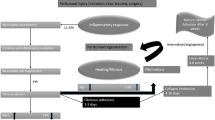Abstract
Background
Peritoneal adhesions are recognized as an important cause for patient morbidity, but complications related to adhesions occur relatively late after the original operation. Therefore preoperative consent may not adequately reflect the proportions of the problem.
Methods
A total of 200 patients admitted for intraperitoneal operations at six hospitals were prospectively reviewed to identify whether adhesion-related complications were documented as possible adverse events in their respective consent forms.
Results
Adhesion-related complications were documented in 8.5% (n = 17) of consent forms (bowel obstruction n = 8, requirement for further operations n = 5, difficult reoperation n = 1, pain n = 3). A direct relationship with adhesions was noted in n = 9 of these consent forms.
Conclusions
Preoperative informed consent does not adequately reflect the magnitude of adhesion-related problems. These findings have immediate implications for clinical practice.
Similar content being viewed by others
References
Parker MC, Wilson MS, van Goor H et al (2007) Adhesions and colorectal surgery—call for action. Colorectal Dis 9(Suppl 2):66–72
Ellis H, Moran BJ, Thompson JN et al (1999) Adhesion-related hospital readmissions after abdominal and pelvic surgery: a retrospective cohort study. Lancet 353:1476–1480
Menzies D, Ellis H (1990) Intestinal obstruction from adhesions—how big is the problem? Ann R Coll Surg Engl 72:60–63
Ellis H (1997) The clinical significance of adhesions: focus on intestinal obstruction. Eur J Surg Suppl 577:5–9
van Goor H (2007) Consequences and complications of peritoneal adhesions. Colorectal Dis 9(Suppl 2):25–34
Stovall TG, Elder RF, Ling FW (1989) Predictors of pelvic adhesions. J Reprod Med 34:345–348
Tulandi T, Collins JA, Burrows E et al (1990) Treatment-dependent and treatment-independent pregnancy among women with periadnexal adhesions. Am J Obstet Gynecol 162:354–357
Marana R, Rizzi M, Muzii L et al (1995) Correlation between the American Fertility Society classifications of adnexal adhesions and distal tubal occlusion, salpingoscopy, and reproductive outcome in tubal surgery. Fertil Steril 64:924–929
Van Der Krabben AA, Dijkstra FR, Nieuwenhuijzen M et al (2000) Morbidity and mortality of inadvertent enterotomy during adhesiotomy. Br J Surg 87:467–471
Wilson MS (2007) Practicalities and costs of adhesions. Colorectal Dis 9(Suppl 2):60–65
Ellis H (2004) Medicolegal consequences of adhesions. Hosp Med 65:348–350
Parker MC, Wilson MS, Menzies D et al (2005) The SCAR-3 study: 5-year adhesion-related readmission risk following lower abdominal surgical procedures. Colorectal Dis 7:551–558
DeWilde RL, Trew G (2007) Postoperative abdominal adhesions and their prevention in gynaecological surgery. Expert consensus position. Part 2—steps to reduce adhesions. Gynecol Surg 4:243–253 (review)
Bhardwaj R, Parker MC (2007) Impact of adhesions in colorectal surgery. Colorectal Dis 9(Suppl 2):45–53
Grant HW, Parker MC, Wilson MS et al (2008) Adhesions after abdominal surgery in children. J Pediatr Surg 43:152–156; discussion 156–157
Menzies D, Parker M, Hoare R et al (2001) Small bowel obstruction due to postoperative adhesions: treatment patterns and associated costs in 110 hospital admissions. Ann R Coll Surg Engl 83:40–46
Zbar RI, Crede WB, McKhann CF et al (1993) The postoperative incidence of small bowel obstruction following standard, open appendectomy and cholecystectomy: a six-year retrospective cohort study at Yale-New Haven Hospital. Conn Med 57:123–127
Ahlberg G, Bergdahl S, Rutqvist J et al (1997) Mechanical small-bowel obstruction after conventional appendectomy in children. Eur J Pediatr Surg 7:13–15
Beck DE, Opelka FG, Bailey HR et al (1999) Incidence of small-bowel obstruction and adhesiolysis after open colorectal and general surgery. Dis Colon Rectum 42:241–248
Nieuwenhuijzen M, Reijnen MM, Kuijpers JH et al (1998) Small bowel obstruction after total or subtotal colectomy: a 10-year retrospective review. Br J Surg 85:1242–1245
MacLean AR, Cohen Z, MacRae HM et al (2002) Risk of small bowel obstruction after the ileal pouch-anal anastomosis. Ann Surg 235:200–206
Fazio VW, Ziv Y, Church JM et al (1995) Ileal pouch-anal anastomoses complications and function in 1005 patients. Ann Surg 222:120–127
Marcello PW, Roberts PL, Schoetz DJ et al (1993) Obstruction after ileal pouch-anal anastomosis: a preventable complication? Dis Colon Rectum 36:1105–1111
Francois Y, Dozois RR, Kelly KA et al (1989) Small intestinal obstruction complicating ileal pouch-anal anastomosis. Ann Surg 209:46–50
Cole A (2008) GMC asks doctors to take greater care over consent after law changes. BMJ 336:1152–1153
Skene L, Smallwood R (2002) Informed consent: lessons from Australia. BMJ 324:39–41
Mazur DJ (2003) Influence of the law on risk and informed consent. BMJ 327:731–734
Ellis H (2001) Medicolegal consequences of postoperative intra-abdominal adhesions. J R Soc Med 94:331–332
Acknowledgments
We gratefully acknowledge the kind help of Umar Ahmad, Dilshad Marikar, Erden Ali, Mohsin Badat, and Ali Alim-Mastavi in collecting data at their respective hospitals.
Author information
Authors and Affiliations
Corresponding author
Rights and permissions
About this article
Cite this article
Rajab, T.K., Wallwiener, M., Talukdar, S. et al. Adhesion-Related Complications Are Common, But Rarely Discussed in Preoperative Consent: A Multicenter Study. World J Surg 33, 748–750 (2009). https://doi.org/10.1007/s00268-008-9917-x
Published:
Issue Date:
DOI: https://doi.org/10.1007/s00268-008-9917-x




